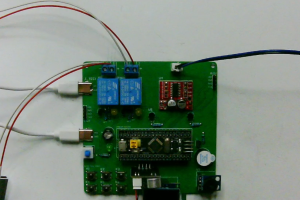设计说明书
总字数:14000+
摘 要
吹风机作为一种常见的家用电器,在日常生活中扮演着重要的角色。然而,传统吹风机通常只提供有限的温度和风速控制选项,用户体验和安全性有限。随着科技的不断发展,越来越多的用户对吹风机的性能和功能提出了更高的要求。因此,设计一种能够更灵活、智能、安全地控制吹风机温度和风速的系统变得愈加重要。此次设计基于STM32F103C8T6单片机的吹风机温度和风速测控系统的设计。该系统具有多种功能,包括加热模式和风速的控制、语音控制、温度检测和显示等。具体来说,该系统的功能如下:首先,通过三个按键可以控制吹风机的加热模式,包括停止、低温和高温模式。这是通过两个继电器实现的,可以有效地控制吹风机的加热功能。其次,同样通过三个按键可以控制吹风机的风速,包括停止、低速和高速。这部分是通过MX1508控制风扇实现的,使用户可以根据需要调整吹风机的风速。此外,系统还支持语音控制功能,用户可以通过语音命令来控制吹风机的温度和风速,提高了系统的便捷性。系统还具备温度检测功能,通过红外传感器检测头发的温度,并通过DS18B20传感器测量外界温度,从而可以自动调节吹风机的工作模式,包括冷风、热风和风速大小,以满足不同的需求。另外,系统还监测吹风机表面温度,当温度超过设定值时,会触发蜂鸣器报警,并切断所有负载的工作,确保安全性。最后,通过OLED显示屏可以显示当前的温度模式、风速模式以及当前温度,为用户提供实时的信息反馈。这个系统综合了多种功能,通过STM32F103C8T6单片机的控制,为吹风机的温度和风速控制提供了更多的选项和便捷性,有望在实际使用中提供更好的用户体验和安全性。
关键词:单片机控制;STM32F103C8T6;吹风机温度控制;风速调节;语音控制;温度检测系统
Abstract
As a common household appliance, hair dryers play a significant role in everyday life. However, traditional hair dryers typically offer limited options for temperature and airflow control, resulting in limited user experience and safety. With the continuous advancement of technology, an increasing number of users have raised higher demands for the performance and functionality of hair dryers. Therefore, designing a system capable of controlling hair dryer temperature and airflow more flexibly, intelligently, and safely has become increasingly important.This design is based on the STM32F103C8T6 microcontroller and focuses on the development of a hair dryer temperature and airflow measurement and control system. The system incorporates various functions, including temperature and airflow control, voice control, temperature sensing, and display. Specifically, the system includes the following features:Firstly, three buttons allow users to control the hair dryer’s heating mode, which includes options for stopping, low-temperature, and high-temperature modes. This functionality is achieved through the use of two relays, effectively managing the hair dryer’s heating capabilities.Secondly, the same three buttons enable users to adjust the hair dryer’s airflow, with choices for stopping, low-speed, and high-speed settings. This feature is implemented using the MX1508 to control the fan, offering users the ability to customize the airflow as per their requirements.Additionally, the system supports voice control, empowering users to control temperature and airflow through voice commands, enhancing the system’s convenience.The system also integrates temperature sensing capabilities, utilizing an infrared sensor to measure hair temperature and a DS18B20 sensor to monitor external temperatures. This enables the system to automatically adjust the hair dryer’s operating mode, including cold air, hot air, and airflow intensity, to meet diverse user needs.Furthermore, the system monitors the hair dryer’s surface temperature. If the temperature exceeds a predetermined threshold, it triggers an alarm through a buzzer and cuts off all loads, ensuring safety.Lastly, an OLED display screen provides real-time feedback, showing the current temperature mode, airflow mode, and the present temperature to the user.This comprehensive system, controlled by the STM32F103C8T6 microcontroller, offers an array of features for hair dryer temperature and airflow control, enhancing the user experience and safety. It has the potential to provide improved user satisfaction and safety in practical use.
Keywords: Microcontroller Control; STM32F103C8T6; Hair Dryer Temperature Control; Airflow Adjustment; Voice Control; Temperature Sensing System..
目 录
基于单片机的吹风机温度风速测控系统设计
摘要
Abstract
第1章 绪论
1.1研究背景及意义
1.2国内外研究现状
1.3论文的主要内容
第2章 系统总体设计方案
2.1系统总体设计
2.2主要模块方案选择
2.2.1主控模块方案选择
2.2.2 环境温度检测模块方案选择
2.2.3 头发温度检测模块方案选择
第3章硬件设计
3.1主控模块电路设计
3.2 语音识别模块电路设计
3.3 非接触测温模块电路设计
3.4 环境温度检测模块电路设计
3.5 显示模块电路设计
3.6 继电器模块电路设计
3.7 直流电机驱动模块电路设计
3.8 蜂鸣器报警模块
3.9 独立按键模块电路
第四章 系统程序设计
4.1 编程软件介绍
4.2 系统主流程设计
4.3 独立按键
4.4 温度检测模块子流程
4.5 OLED显示流程设计
4.6 直流电机-MX1508驱动模块子流程
第5章实物测试
5.1 整体实物焊接图
5.2 吹风机加热模式控制实物测试
5.3 吹风机风速控制实物测试
5.4 语音控制吹风机实物测试
5.5 吹风机表面温度测控实物测试
第6章 总结展望
参考文献
附录
附录A 原理图
附录B PCB
附录C 主程序
购买后可查看具体内容!

